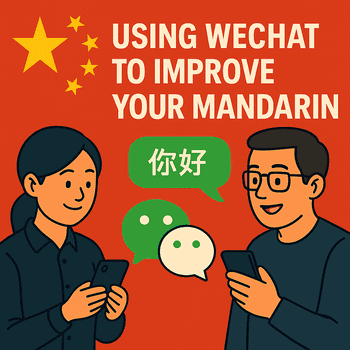
WeChat (微信, Wēixìn) has evolved far beyond its origins as a messaging app to become China’s digital ecosystem hub, with over 1.3 billion active users worldwide.
For Mandarin learners, WeChat offers an unparalleled immersive environment that combines authentic content, native speaker interactions, and specialized learning tools.
This updated guide explores how to leverage WeChat’s latest features to accelerate your Mandarin proficiency in 2025.
1. WeChat’s Evolving Language Learning Ecosystem
WeChat’s value for language learners has expanded dramatically with recent updates focused on accessibility and learning integration:
- Multilingual Interface – WeChat now supports 18 languages, making navigation intuitive for non-Chinese speakers.
- AI-Enhanced Translation – The 2025 translation engine handles complex sentences, slang, and even dialect variations with remarkable accuracy.
- Mini Program Translation – As of January 2025, WeChat’s Mini Programs support automatic translation into 18 languages, removing barriers to accessing Chinese-only content.
- Integrated Learning Tools – Specialized features for vocabulary acquisition, pronunciation practice, and cultural understanding.
According to WeChat’s official blog, “This feature removes language barriers, allowing seamless use of Mini Programs without the need to learn Chinese,” though ironically, this accessibility makes WeChat an even more powerful platform for those who do want to learn.
2. Specialized Language Learning Mini Programs
Mini Programs function as lightweight apps within WeChat, and several excellent options now exist specifically for Mandarin learners:
Top Mandarin Learning Mini Programs in 2025:
| Mini Program | Focus Area | Key Features | Best For |
|---|---|---|---|
| WeChat Mandarin | Comprehensive learning | 90 structured video lessons, interactive exercises | Beginners to intermediate |
| ChineseSkill | Character recognition | Handwriting practice, stroke order animation | Character learning |
| Daily Chinese | Practical phrases | Context-based learning, daily challenges | Conversational Chinese |
| HSK Prep | Test preparation | Mock exams, vocabulary drills by HSK level | Exam candidates |
| Chinese Idioms | Cultural literacy | Stories behind common chengyu, usage examples | Intermediate+ learners |
The WeChat Mandarin Mini Program developed by New Concept Mandarin offers particularly strong structured learning with approximately HK$1 per lesson, making it one of the most cost-effective options available.
3. Enhanced Voice Message Features for Pronunciation Practice
WeChat’s voice messaging capabilities have been significantly upgraded, making them powerful tools for pronunciation practice:
How to Maximize Voice Message Learning:
- Voice-to-Text Verification – Record messages and check if the automatic transcription matches your intended phrase.
- Slow Playback – The 2025 update allows playing voice messages at 0.5x speed to catch pronunciation nuances.
- Pronunciation Feedback – Some language exchange Mini Programs now integrate with WeChat to provide AI-powered pronunciation scoring.
- Voice Message Collections – Save voice exchanges with native speakers in dedicated folders for later review.
According to FluentU’s 2025 guide, “The voice message function on WeChat is very handy… you can use the voice message function to practice your speaking and listening skills in Mandarin,” with the added benefit that voice messages create lower-pressure speaking opportunities than real-time conversation.
4. Finding Language Partners Through WeChat
WeChat offers multiple pathways to connect with native Mandarin speakers and fellow learners:
Effective Methods to Find Language Partners:
- Language Exchange Groups – Search for “语言交换” (yǔyán jiāohuàn) or “Chinese-English exchange”
- University Networks – Many Chinese universities have WeChat groups for international students
- Interest-Based Communities – Join groups focused on hobbies to practice Mandarin in context
- Professional Networks – Industry-specific groups provide specialized vocabulary practice
The 2025 “Nearby” feature now includes language preference filters, making it easier to find language exchange partners in your vicinity who are interested in mutual language practice.
5. WeChat Channels for Authentic Content Immersion
Channels (视频号, shìpín hào) is WeChat’s short-video platform that provides authentic, current Mandarin content:
Top Channel Categories for Learners:
| Content Type | Learning Benefits | Recommended Accounts |
|---|---|---|
| Cooking Channels | Food vocabulary, instructional language | 美食台 (Měishí Tái), 下厨房 (Xià Chúfáng) |
| Travel Vlogs | Location-specific terms, cultural insights | 旅行志 (Lǚxíng Zhì), 环球旅行 (Huánqiú Lǚxíng) |
| Comedy Sketches | Colloquial expressions, humor | 开心麻花 (Kāixīn Máhuā), 脱口秀大会 (Tuōkǒuxiù Dàhuì) |
| Educational Content | Academic vocabulary, clear pronunciation | 知识就是力量 (Zhīshì Jiùshì Lìliàng) |
| Daily Life Vlogs | Everyday conversation, current slang | 日常生活分享 (Rìcháng Shēnghuó Fēnxiǎng) |
The “For You” algorithm can be trained to show more Mandarin learning content by consistently engaging with language-related videos.
According to Beijing Kids’ 2024 article, the translation feature now extends to video captions, making Channels content more accessible to learners at all levels.
6. WeChat Top Stories for Reading Practice
The Top Stories feature provides access to articles at various difficulty levels:
How to Optimize Reading Practice:
- Use the “Listen to Full Text” feature – Hear proper pronunciation while following along with text
- Create topic-specific reading collections – Save articles on similar themes to build vocabulary in areas of interest
- Utilize the paragraph translation feature – Toggle between Chinese and English to check comprehension
- Engage with comments – Practice reading authentic, conversational responses from native speakers
The 2025 update introduced a “Language Learning Mode” that highlights key vocabulary and provides instant definitions when reading articles, significantly enhancing the reading experience for learners.
7. Creating Content as a Learning Strategy
Actively creating content on WeChat provides valuable production practice:
Content Creation Learning Activities:
- Daily Moments posts – Share short updates in Mandarin to practice writing
- Voice Channels – Record short videos explaining topics you’re familiar with
- Group chat challenges – Participate in writing or speaking challenges in learning groups
- Mini-essays in Notes – Use the Notes feature to write longer pieces for feedback
According to language acquisition research, production activities significantly enhance retention and practical language ability.
The low-pressure environment of WeChat makes it ideal for experimenting with new vocabulary and grammar patterns.
8. Regional Language Variations and Dialect Exposure
WeChat provides unique opportunities to encounter regional Mandarin variations:
Regional Language Features on WeChat:
| Region | Dialect Characteristics | How to Find on WeChat |
|---|---|---|
| Northern China | Standard pronunciation, distinctive r-coloring | Official media accounts, Beijing-based groups |
| Shanghai/Eastern | Wu influence, softer consonants | Local service Mini Programs, Shanghai community groups |
| Sichuan/Chongqing | Distinctive tone patterns, unique vocabulary | Regional food channels, Sichuan culture accounts |
| Taiwan | Traditional characters, unique expressions | Taiwan-focused media, entertainment accounts |
| Singapore | English influence, Hokkien elements | Singaporean community groups, news accounts |
Following location-based accounts from different regions exposes you to authentic regional speech patterns that textbooks rarely cover.
9. Integrating WeChat with Other Learning Tools
WeChat works best as part of a comprehensive learning strategy:
Effective Integration Methods:
- Vocabulary Management – Use vocabulary from formal courses in WeChat conversations
- Grammar Application – Consciously practice new grammar patterns in chat exchanges
- Content Sharing – Share interesting WeChat articles with tutors for discussion
- Progress Documentation – Record voice samples over time to track pronunciation improvement
Many language schools now maintain WeChat groups for students, creating a seamless connection between formal learning and practical application.
10. Cultural Context Through WeChat Interactions
Beyond language mechanics, WeChat provides invaluable cultural insights:
Cultural Learning Opportunities:
- Holiday celebrations – Observe how festivals are discussed and celebrated
- Business etiquette – Note communication patterns in professional contexts
- Generational differences – Compare language use between different age groups
- Digital culture – Learn internet slang and meme references unique to Chinese social media
Understanding these cultural elements is essential for natural, appropriate language use.
As Baba Goes China’s 2025 guide notes, “WeChat is far more than just a messaging app – it’s essentially the operating system for daily life in China.”
11. Advanced Features for Serious Learners
For committed learners, several advanced WeChat features offer deeper language immersion:
Power User Features:
- Custom Keyboard Settings – Configure handwriting input for character practice
- Voice-to-Text Analysis – Use transcription to identify pronunciation issues
- Content Recommendation Training – Deliberately shape your algorithm for language learning
- Cross-Platform Integration – Connect WeChat with specialized learning apps via shared login
These advanced features transform casual usage into structured learning opportunities, particularly valuable for self-directed learners.
12. Practical Learning Scenarios
Here are real-world scenarios where WeChat facilitates language learning:
Case Study: Restaurant Ordering
Use Mini Program translation to understand menus, then practice ordering in Mandarin with voice messages to friends before trying in person.
Case Study: Travel Planning
Join regional travel groups to learn destination-specific vocabulary and cultural norms before your trip.
Case Study: Professional Networking
Connect with industry peers through WeChat groups to learn field-specific terminology and communication styles.
Final Thoughts
In 2025, WeChat offers perhaps the most comprehensive digital immersion environment available for Mandarin learners.
Its integration into virtually every aspect of Chinese life provides authentic language exposure that traditional learning methods cannot match.
The key to success is transforming everyday WeChat usage into deliberate practice—engaging with native content, connecting with speakers, utilizing specialized learning features, and creating your own content.
With consistent, purposeful use, WeChat becomes not just a communication tool but a personalized language learning ecosystem.
As FluentU’s 2025 guide concludes, “I’m sure that after getting used to the app and doing some sleuthing, you’ll start seeing great results from using WeChat consistently.”



